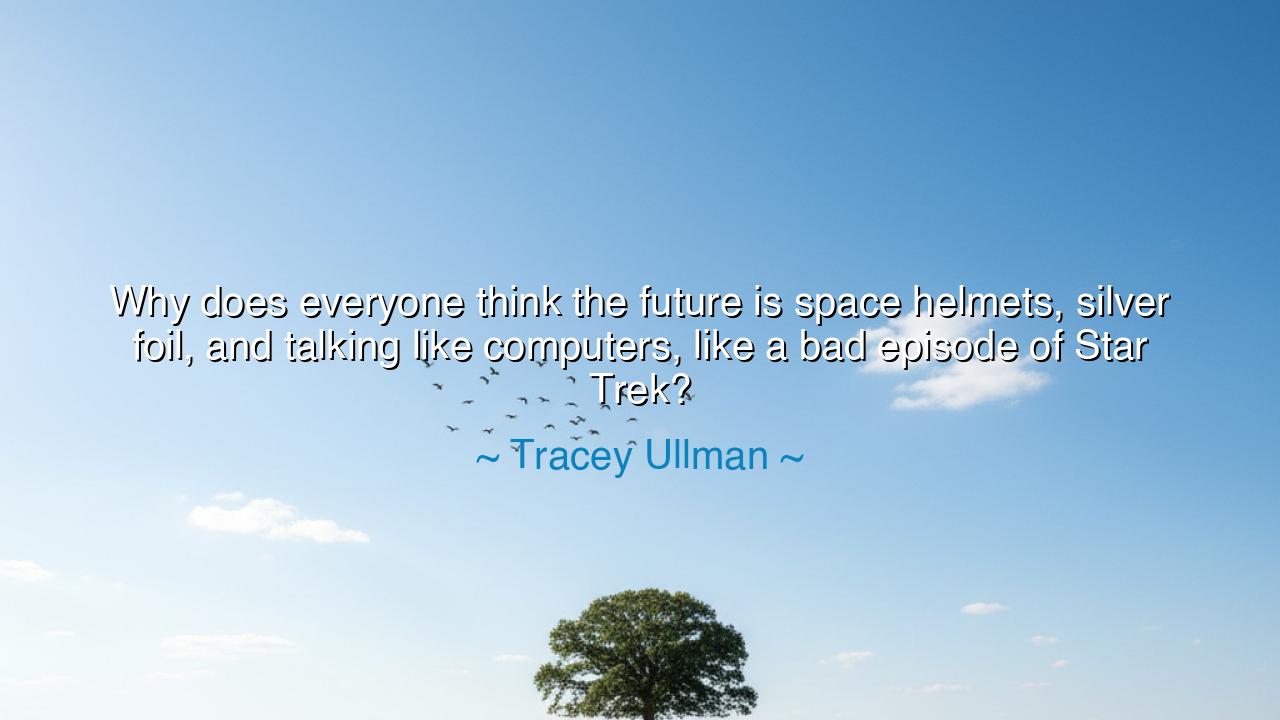
Why does everyone think the future is space helmets, silver foil
Why does everyone think the future is space helmets, silver foil, and talking like computers, like a bad episode of Star Trek?






"Why does everyone think the future is space helmets, silver foil, and talking like computers, like a bad episode of Star Trek?" These words of Tracey Ullman carry a sharp and playful critique of how the future is often imagined in popular culture. She questions why so many people have come to associate the future with cold, mechanical imagery—the futuristic technology, the shiny silver surfaces, the robotic speech. In truth, this portrayal of the future as a sterile, impersonal world of artificiality is not only limiting but also a misrepresentation of what the future might truly be. It reflects a narrow vision, one that overlooks the potential for a future that is deeply human, organic, and full of possibility.
In ancient times, visionaries and philosophers sought to understand the nature of the future, often imagining it as a time of wisdom, enlightenment, or struggle. The ancient Greeks, for example, envisioned a world in which humanity could achieve its highest ideals, whether through philosophical inquiry or the quest for virtue. Plato, in his Republic, described a future society where individuals would live in harmony, governed by reason and justice. Yet, even the great thinkers of the past recognized that the future is not something that can be easily boxed into a singular, rigid image. They knew that the future would be shaped by human choices, and as such, it would always be a fluid, evolving entity, one that would not be confined to predictable or mechanical models.
The idea of the future as a world of robots, space travel, and synthetic living is not a new one. It is a vision that can be traced back to the earliest sci-fi writers, such as H.G. Wells and Jules Verne, who explored the possibilities of space exploration and advanced technology in their works. However, in their stories, the future was always more than just a sterile existence of gears and wires. Even as they imagined new technologies, they also grappled with the human implications of those technologies, often asking whether progress would lead to a world of greater freedom or greater oppression. Wells, for example, in The Time Machine, showed us a future where the division of classes had led to a tragic collapse of humanity, reminding us that technological advancement alone cannot guarantee a better future.
Indeed, the future is not simply a time of technological advancement, but a reflection of humanity’s journey. Leonardo da Vinci, centuries before space helmets and silver foil, envisioned flying machines and futuristic inventions, not just because he was fascinated by technology, but because he was deeply moved by the possibilities of what humanity could achieve if it dared to dream. His vision of the future was intertwined with creativity, art, and the very essence of what it means to be human. Da Vinci understood that the future should not be limited to a vision of cold machinery, but should reflect the beauty and depth of the human spirit—a theme that is often overlooked in the more mechanical visions of the future.
The lesson Ullman imparts here is not just a critique of science fiction’s depiction of the future but a challenge to reimagine what the future could look like. She invites us to think of a future that is not about robotic speech or artificial intelligence ruling our lives but one that is rooted in humanity, connection, and creativity. The future is not something that happens to us; it is something we create through our actions, our values, and our willingness to dream. The future should not be a cold, unfeeling place dominated by technology but a vibrant, living world where technology serves as a tool to enhance our lives, not replace them.
History is filled with examples of human ingenuity that go beyond simple technological advances. Mahatma Gandhi, whose vision for India’s future was not one of technological domination but of freedom and nonviolent resistance, reshaped the future of his country through his ideas, not through mechanical innovation. Similarly, Martin Luther King Jr. imagined a future of equality and justice, where the arc of history bent toward righteousness, a vision grounded in the human heart rather than the cold steel of machines. These leaders understood that the future is built on the strength of human connections, ideas, and values—not just the latest inventions.
So, what is the practical action we can take in light of Ullman’s quote? We must shift our vision of the future from a sterile, mechanical world to one that celebrates human potential. We must ask ourselves: What kind of future do we want to create? A future defined by technology alone, or a future that reflects our shared humanity, creativity, and compassion? Our thoughts, actions, and innovations should be guided by a vision that enhances life, deepens relationships, and fosters growth. Let us build a future where the human spirit is not eclipsed by machines, but empowered by them, a future that truly reflects the essence of what it means to be alive, connected, and thriving.






AAdministratorAdministrator
Welcome, honored guests. Please leave a comment, we will respond soon